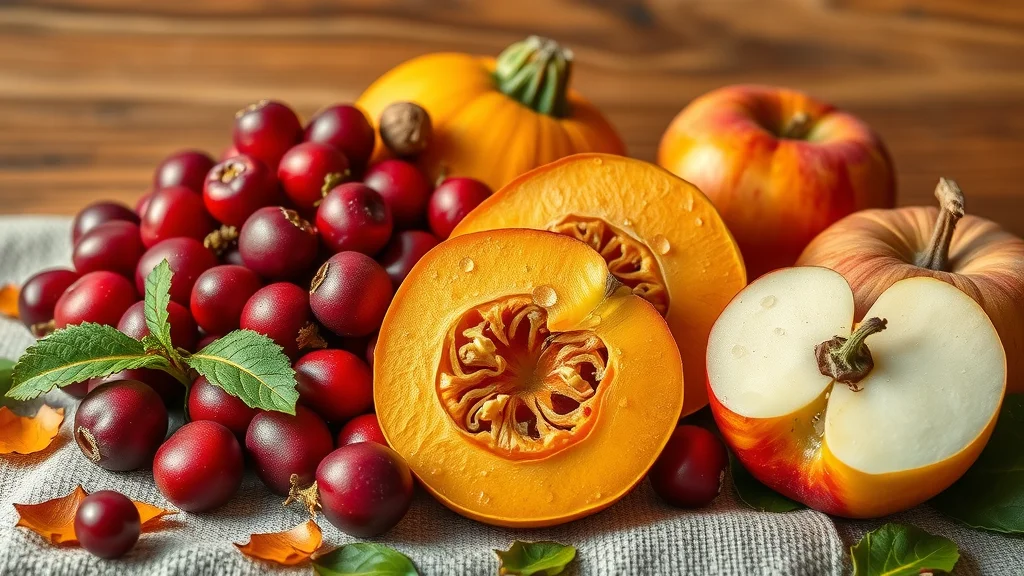Did you know the original Thanksgiving feast included foods that could boost your gut health today? The first celebration, shared between the Pilgrims and Wampanoag, looked nothing like modern holiday spreads but held hidden secrets to digestive wellness.
As families gather for turkey and mashed potatoes this season, understanding and reviving these ancestral traditions could be the key to a happier, healthier gut. In this article, we peel back the layers of history to reveal what was really on the table and why your digestive system might thank you for bringing these foods back.

Did You Know? The Surprising Link Between the First Thanksgiving and Gut Health
The first Thanksgiving meal wasn't just a historical event; it was a celebration rooted in seasonal abundance and foods that naturally supported gut health. Where today’s holiday season often packs our tables with rich gravies, heavy casseroles, and sugary desserts, the original feast leaned on ingredients instinctively chosen for their nutritional and instinctual value. Early dishes featured fiber-rich beans, wild greens, root vegetables, squat, and native fruits—foods that are now recognized for their power to nurture digestive wellness.
Understanding the relationship between these foods and the gut microbiome reveals how the Pilgrims and Wampanoag inadvertently supported their digestive system. Many ingredients, like beans and squash, contain prebiotics—fibers that feed the beneficial bacteria in your intestines.
Modern research shows that including these elements in a Thanksgiving meal plan offers more than just tradition; it brings science-backed benefits to digestion, regularity, and gut bacteria diversity. Refreshing your table with ancestral wisdom could mean fewer post-feast belly aches and a healthier gut this holiday season.
While focusing on gut-friendly foods is essential, it's also important to be aware of underlying digestive issues that may go unnoticed. For example, millions of Americans are affected by hidden stomach conditions that can impact how well your body responds to even the healthiest holiday meals. Learn more about these often-overlooked stomach conditions and how they might influence your digestive wellness as you plan your Thanksgiving menu.

How the Original Thanksgiving Meal Supported Gut Health
From the wild beans and harvested squash to tart cranberries and hearty greens, every side dish at the first Thanksgiving supported digestive and overall health. Unlike today’s processed fare, the original meal focused on minimally prepared, whole foods. The high fiber content in those beans and wild greens ensured slow, gentle digestion and promoted a thriving community of beneficial gut bacteria. Root vegetables brought in resistant starch—a special fiber that powers the intestinal microbiome and helps with regularity, while native fruits like pumpkin and cranberry delivered antioxidants and gentle sugars for sustained energy.
The synergy of these ingredients offered a balanced array of nutrients and fibers that can reduce the risk of digestive upset and promote a more resilient, healthy gut. If you’re looking to avoid the sluggish, uncomfortable feeling that often follows a modern feast, consider how a return to these roots could transform your body’s response. By learning from the culinary wisdom of the Pilgrims and Wampanoag, we discover practical steps for optimizing gut health without sacrificing Thanksgiving tradition.
What You’ll Learn About Thanksgiving Gut Health in This Article
The core gut-friendly ingredients at the first Thanksgiving meal
Modern ways to bring ancestral gut health wisdom to your table
Research-backed links between holiday season foods and digestive wellness
1. Beans: A Thanksgiving Gut Health Staple Lost and Rediscovered

Why Beans and Bean Casserole Were Essential for Gut Health
Beans were not just a hearty protein for early settlers and Native Americans—they were the original gut health champions. Rich in soluble fiber and resistant starch, beans supply essential food for beneficial bacteria in the gut microbiome. Unlike many modern side dishes, a simple bowl of beans—whether whole or in a casserole—offers a slow-digesting source of energy that can help maintain blood sugar and reduce inflammation in the digestive system. As Dr. Emily Zhou, a leading nutrition scientist, explains:
"Beans are one of the richest sources of soluble fiber, which nourishes the gut microbiome and supports digestive regularity," says Dr. Emily Zhou, nutrition scientist.
Modern versions, like green bean casserole, often lose gut health benefits due to high-fat sauces and processed ingredients. To restore their powerful properties, focus on beans as a good source of fiber, offering a plant-based protein that helps relieve irritable bowel symptoms and supports overall intestinal health. Simple swaps, such as using olive oil instead of butter or processed fats, can revive this classic as a true Thanksgiving gut health ally.
2. Wild Greens & Green Bean Dishes: Ancient Fiber for Modern Holiday Season Gut Health
From Wild Greens to Green Bean Casserole: Evolving Thanksgiving Gut Health Classics
The greens that graced the original meal weren’t always the green beans or casseroles we know today but included wild plants like lamb’s quarters, dandelion, and amaranth. These wild greens were exceptionally high in fiber and phytonutrients, feeding beneficial bacteria while delivering vitamins and minerals vital for a strong digestive system. Today’s green bean casserole can mirror this benefit if we choose minimally processed ingredients and favor steaming or roasting, limiting processed additives.
Both wild greens and modern green beans are excellent for digestive health, offering bulk to move waste smoothly through the gut and feeding the microbiome with prebiotic fibers.
Adding sautéed green beans or a lighter green bean casserole—prepared with olive oil, herbs, and crunchy nuts instead of heavy cream soups—can combine the nostalgia of traditional side dishes with the science of gut wellness. This is a holiday season upgrade your body will appreciate.
3. Squash and Sweet Potato: Nourishing Thanksgiving Gut Health for Centuries

Sweet Potatoes and Their Prebiotic Power for Gut Health
Long before sweet potato casserole loaded with marshmallows, the Wampanoag and Pilgrims enjoyed roasted squash and sweet potatoes as foundational elements of their diet. Both root vegetables are loaded with vitamins, minerals, and especially prebiotic fiber—the kind that feeds good bacteria and helps the gut thrive. Research now shows their unique carbohydrates, including resistant starch, encourage a healthier digestive tract and can soothe symptoms of irritable bowel syndrome.
Swapping candied sweet potatoes for simple roasted or mashed preparations not only preserves tradition but also supports better holiday season gut health. These naturally sweet roots can stabilize energy, reduce cravings, and assist the digestive system in breaking down other heavy foods on the plate. For an added boost, drizzle with olive oil and sprinkle with warming spices for a nutrient-dense, microbiome-friendly side dish.
4. Root Vegetables & Mashed Potatoes: Starches That Soothe and Strengthen Gut Health
How Traditional Mashed Potatoes Can Be a Gut Health Ally
Far from being just comfort food, potatoes and other root vegetables deliver a complex carbohydrate punch that your gut bacteria love. Traditional mashed potatoes, when prepared with the skins and a splash of olive oil in place of butter, act as a vehicle for resistant starch. This substance is fermented by your intestinal bacteria, turning into short-chain fatty acids that fuel your colon and maintain gut health.
If you suffer from digestive discomfort, opting for homemade mashed potatoes—rather than processed, instant varieties—means more fiber, less sodium, and fewer problematic fats for your body to handle. Including turnips, parsnips, or carrots alongside potatoes diversifies your nutrient intake and provides a broader base of gut-friendly compounds. These classic side dishes are simple, filling, and surprisingly supportive of a balanced digestive system.
5. Native Fruits: Cranberries, Pumpkins, and the Perfect Thanksgiving Gut Health Endings

Pumpkin Pie Reimagined: Nourishing Your Gut During the Holiday Season
Pumpkins and cranberries weren’t just festive centerpieces—they were packed with antioxidants and fiber that support gut bacteria and the digestive process. While modern pumpkin pie is often loaded with refined sugars and heavy creams, it’s possible to reimagine this favorite for a gut health boost. Using fresh pumpkin, a touch of natural sweetener, and a whole grain or nut crust transforms dessert into a nourishing end to your Thanksgiving meal.
Cranberries, tart and rich in polyphenols, help prevent inflammation and may lower the risk of gut infections. When you choose cranberry sauces and desserts made with whole berries and limited added sugars, you deliver valuable antioxidants and mild prebiotics to your digestive tract. Tradition can be tasty and beneficial: a simple, wholesome pumpkin pie or fresh cranberry compote may leave everyone satisfied—and your gut bacteria grateful.
6. Olive Oil and Nuts: Forgotten Fats That Enhance Gut Health in Holiday Season Feasting
The Role of Olive Oil in Ancestral and Modern Thanksgiving Gut Health
Healthy fats were a staple in ancestral diets—even if they looked slightly different from today's fats. Although butter is a modern favorite, olive oil and nuts were accessibility choices in both early colonial America and Indigenous foodways. Olive oil is now recognized for feeding beneficial bacteria, decreasing inflammation, and supporting the lining of the digestive tract.
Sprinkling nuts and seeds over your dishes adds fiber, plant proteins, and healthy monounsaturated fats, all of which support a healthy gut microbiome and can help prevent overeating. Replace butter with olive oil in cooking and salad dressings for an easy holiday season swap that boosts digestibility and gives dishes an earthy, satisfying flavor—with a nod to both tradition and modern nutritional science.
Comparison Table: Traditional Thanksgiving Foods vs Modern Dishes for Gut Health
Traditional Thanksgiving Foods |
Modern Version |
Gut Health Benefits |
|---|---|---|
Whole Beans (stewed, roasted) |
Green bean casserole (with fried onions, creamy soups) |
More fiber, prebiotics, less processed fat when kept whole and simple |
Wild Greens / Green Beans |
Canned green beans, cream-based casseroles |
Higher in vitamins, minerals, and prebiotics when freshly prepared with olive oil |
Roasted Squash/Sweet Potatoes |
Candied sweet potatoes, marshmallow-topped sides |
Supports gut bacteria, provides resistant starch, less sugar crash |
Plain Mashed Potatoes (with skins, olive oil) |
Instant mashed potatoes, added butter and cream |
More fiber, better for digestive system, less saturated fat |
Fresh Cranberries / Pumpkin (baked or stewed) |
Sugary sauces, store-bought pumpkin pie |
Antioxidants, lower sugar, improved gut bacteria diversity |
Olive Oil & Nuts as garnishes/fats |
Butter, processed oils |
Supports good cholesterol, reduces inflammation, feeds microbiome |
People Also Ask: Your Top Thanksgiving Gut Health Questions, Answered
What are some common digestive issues that can arise during Thanksgiving feasts?
During a large Thanksgiving meal, it’s common to encounter bloating, indigestion, and heartburn—especially when eating heavy, fatty, or sugary foods in large quantities. Consuming too much at once can overwhelm the digestive system, leading to discomfort or symptoms like cramping, constipation, or even exacerbating conditions like irritable bowel syndrome. Choosing smaller portions and including lots of fiber-rich vegetables can help prevent these common issues.
What is the 7 day gut reset?
A 7 day gut reset is a short-term meal plan focused on rebalancing the gut microbiome, reducing processed foods, and increasing fiber-rich whole foods like beans, root veggies, fruits, and green beans. It involves mindful choices—replacing heavy side dishes with lighter options, eating more fermented or prebiotic foods, and avoiding added sugars or excess fat. The goal is to allow beneficial bacteria to flourish, support healthy digestion, and improve overall digestive health.
How does Thanksgiving dinner affect your body?
Thanksgiving dinner can impact the body in several ways. Large, rich meals can slow down digestion, causing feelings of heaviness and sluggishness. High-sugar and high-fat foods may disrupt the balance of healthy gut bacteria, while excessive portions put extra strain on the digestive system. Including more prebiotic fibers, healthy fats like olive oil, and smaller portions of protein can ease the burden and help your body handle traditional holiday season indulgence.
Is turkey good for your gut health?
Turkey itself is a lean protein and can be a good option for gut health when eaten in moderate amounts. It contains amino acids necessary for cellular repair, but it’s best paired with high-fiber side dishes and prepared with minimal added fats or artificial ingredients. Avoid overconsumption and balance with vegetables, beans, or root vegetables for a Thanksgiving meal that supports both satisfaction and a healthy gut.

Simple Lists for Better Thanksgiving Gut Health: Easy Food Swaps & Tips
Add more beans and green vegetables to your Thanksgiving meal for increased fiber and beneficial bacteria support.
Swap refined sugar for natural fruit in desserts to reduce gut-disrupting sugars and provide antioxidants.
Incorporate olive oil instead of butter where possible to boost healthy fats and aid digestive wellness.
Quotes from an Expert: Why Gut Health Should Be a Holiday Season Priority
"Understanding our culinary heritage can inspire healthier traditions that benefit both our digestion and long-term well-being," says Dr. Carla Martin, food historian.

FAQs About Thanksgiving Gut Health and Ancestral Food Traditions
Are fermented foods part of the original Thanksgiving meal?
While some Native American groups practiced fermenting foods, most evidence suggests that fermented foods were not a central part of the first Thanksgiving meal. Instead, the focus was on fresh, seasonal produce and wild-caught proteins. However, adding fermented sides like sauerkraut or pickled vegetables to your holiday season menu today can further boost gut health by introducing beneficial bacteria.
What modern Thanksgiving dishes are worst for gut health?
Heavy casseroles made with processed ingredients, fatty gravies, sugary desserts like traditional pumpkin pie, and instant mashed potatoes are some of the most challenging for the digestive system. These dishes are low in fiber, high in unhealthy fats, and can disrupt the balance of good bacteria in the gut. Moderation and healthier swaps are key for maintaining digestive wellness during the holiday season.

Key Takeaways: Reimagining Thanksgiving for Gut Health in the Holiday Season
Historical ingredients from the first Thanksgiving meal can support modern gut health
Adding fiber-rich and minimally processed foods reduces digestive discomfort
Simple swaps make classic dishes more gut-friendly without sacrificing tradition
Ready to Transform Your Thanksgiving Gut Health? Subscribe for More Wellness Wisdom
Want more evidence-based tips for gut-healthy holiday eating and heritage-inspired wellness? Subscribe now to stay updated!
Conclusion
Embracing ancestral foodways for Thanksgiving isn’t just about tradition—it’s a path to better digestion, balanced energy, and a gut you’ll thank all season long.
If you’re inspired to take your wellness journey even further, consider how the foods you choose throughout the year can impact not just your gut, but your overall vitality. Exploring nutrient-dense options—like those that support strong muscles and energy—can help you build a foundation for lasting health.

For more ideas on how to nourish your body beyond the holiday table, discover seven powerful foods that can strengthen your legs and elevate your wellness routine. Let your next step be a holistic approach to nutrition that supports every part of you, from your digestive system to your daily strength.
Sources
https://www.hsph.harvard.edu/nutritionsource/healthy-eating-plate/
https://www.healthline.com/nutrition/thanksgiving-foods-for-gut-health
Exploring the connection between traditional Thanksgiving foods and gut health reveals that many classic dishes can be both delicious and beneficial for digestion. For instance, sweet potatoes are rich in dietary fiber and antioxidants, supporting a healthy gut microbiome. (guthealth.org)
Similarly, incorporating fermented foods like yogurt or sauerkraut into your meal can introduce beneficial probiotics, enhancing digestive health. (medindia.net)
By thoughtfully selecting and preparing these traditional ingredients, you can enjoy a festive feast that also promotes gut wellness. NCWellnessHub.com
 Add Row
Add Row  Add
Add 



Write A Comment